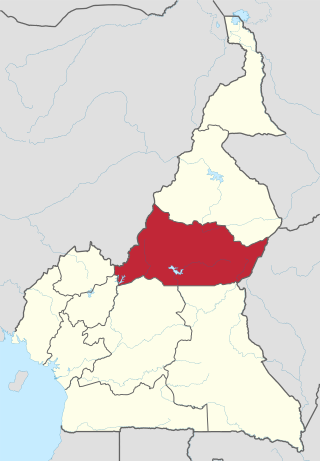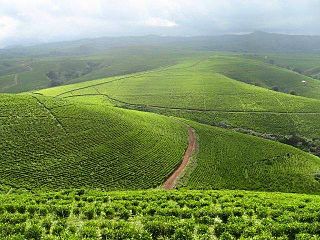
The Adamawa Region is a constituent region of the Republic of Cameroon. It borders the Centre and East regions to the south, the Northwest and West regions to the southwest, Nigeria to the west, the Central African Republic (CAR) to the east, and the North Region to the north.

The Bamiléké are a group of 90 closely related peoples who inhabit the Western High Plateau of Cameroon. According to Dr John Feyou de Hapy, Bamiléké means people of faith.

Taraba State is a state in north-eastern Nigeria, named after the Taraba River, which traverses the Southern part of the state. Taraba State capital is Jalingo. Its slogan is Nature's Gift to the Nation. The main ethnic groups are the Mumuye, Mambilla, Jukun, Tiv, Kuteb, Wurkun, Yandang, Ndola, Itchen, Jenjo, Tigun, Jibu and Fulani. The northern part is mainly dominated by the Mumuye, Wurkuns, Yandang, Jenjo, Kona and Fulani. The southern parts are dominated by the Jukun, Chamba, Tiv, Kuteb and Ichen.The central region is mainly occupied by Mambilla, Ndola, Tigun, Jibu, Wurbo, Daka and Fulani. There are 77 distinct ethnic groups, and their languages in the State.
Nggam is a type of divination found among many groups in western Cameroon. Among the best documented is its practice by the Mambila people of Cameroon and Nigeria, in which the actions of spiders or crabs are interpreted by the diviner. The form used by the neighbouring Yamba people was described by Gebauer in 1964 based on experience in Mbem going back to before 1939, and more recently by Hermann Gufler. Good documentation of Nggam has been also published for the Bekpak (Bafia) people by Dugast and for Bamileke people by Pradeles de Latour. The crab form has been studied in north Cameroon by Walter van Beek.

The Tikar are a Central African people who inhabit the Adamawa Region and Northwest Region of Cameroon. They are known as great artists, artisans and storytellers. Once a nomadic people, some oral traditions trace the origin of the Tikar people to the Nile River Valley in present-day Sudan. Such ethnic groups were referred to in the 1969 official statistics as "Semi-Bantus" and "Sudanese Negroes." They speak a Northern Bantoid language called Tikar. One of the few African ethnic groups to practice a monotheistic traditional religion, the Tikar refer to God the Creator by the name Nyuy. They also have an extensive spiritual system of ancestral reverence.
SardaunaLocal Government Area is located in the extreme southeast of Taraba State in Nigeria. It is synonymous with the Mambilla Plateau, which is dotted by many towns and villages. The capital of the LGA is Gembu, an ancient Mambilla settlement whose name is a corruption of "Gelmvu", the name of an ancient monarch of the area. Other ethnic groups from the mainstream Nigeria and neighbouring Cameroon Republic such as Hausa, Kanuri, Banso, Kambu, Fulani, etc can be found in the commercial centres.
The Kingdom of Bamoun was a Central African state in what is now northwest Cameroon. It was founded by the Bamun, an ethnic group from northeast Cameroon. Its capital was the ancient walled city of Fumban. The kingdom came under control of German West Africa in 1916.
The Chamba are a significant ethnic group in the north eastern Nigeria. The Chamba are located between present day Nigeria and Cameroon. The closest Chamba neighbours are the Mumuye, the Jukun and Kutep people. In Cameroon, the successors of Leko and chamba speakers are divided into several states: Bali Nyonga, Bali Kumbat, Bali-Gham, Bali-Gangsin, and Bali-Gashu. They are two ethnic groups in Ghana and Togo also called Chamba, but they are ethnically distinct. The Chamba are identified through their own language, beliefs, culture, and art.
Dorofi is a small town on the Mambilla Plateau in Taraba State in Central Eastern part of Nigeria. It is 40 km from Gembu, the Sardauna Local Government Area headquarters. It is located on Nigeria's border with Cameroon Republic. It has a temperate climate, with a mean air temperature of 17.5 °C (63.5 °F). It is among the coldest towns in Nigeria. Dorofi's landscape consists of hills and valleys. The people of Dorofi engage in small-scale farming down the hills and cattle grazing up the hills. Views from different sites of Dorofi show plantations of eucalyptus, used for building materials as well as a source of energy for domestic work and warming in cold winters.

The Mambilla Plateau is a plateau in the Taraba State of Nigeria. The Mambilla Plateau has an average elevation of about 1,600 metres (5,249 ft) above sea level, making it the highest plateau in Nigeria. Some of its villages are situated on hills that are at least 1,828 metres (5,997 ft) above sea level. Some mountains on the plateau and around it are over 2,000 metres (6,562 ft) high, like Gang or Chappal Waddi which has a height of 2,419 metres (7,936 ft) above sea level. It is the highest mountain in Nigeria and in West Africa. The Mambilla Plateau measures about 96 km (60 mi) along its curved length; it is 40 km (25 mi) wide and is bounded by an escarpment that is about 900 m (2,953 ft) high in some places. The plateau covers an area of over 9,389 square kilometres (3,625 sq mi).
The Ngel Nyaki Forest Reserve, whose site is historically known as Majang, is situated on the Mambilla Plateau in North East Nigeria, covering 46 km2. It can be reached on foot from Yelwa village past the Mayo Jigawal, from where it is less than half an hour’s walk to the upper edge of the forest. The elevation ranges from 1,400 metres (4,593 ft) to 1,600 metres (5,249 ft). Ngel Nyaki was formally gazetted a local authority Forest Reserve under Gashaka - Mambilla Native Authority Forest order of April 1969, but presently it is under the management of the Taraba State Government and the Nigerian Conservation Foundation (NCF), with the Nigerian Montane Forest Project (NMFP) as a project partner.

Gembu is a town on the Mambilla Plateau in Taraba State of Nigeria. It is the headquarters of Sardauna Local Government Area in Taraba State.
Mambila is a dialect chain stretching across Nigeria and Cameroon. It is one of the Mambiloid languages, a branch of Benue–Congo.
Somyev (Somyewe), also known as Kila, is a nearly extinct Mambiloid language of two villages, one in Nigeria and one in Cameroon, that is spoken by a caste of blacksmiths that live among the Mambila. Although the language is still used for daily communication, the youngest generation of speakers were born in the 1950s. Transmission of the language ceased when the profession of blacksmithing lost its social status, partly due to imports of foreign tools.
Njerep (Njerup) is a Mambiloid language spoken in the Adamawa Region of Cameroon. Njerep is essentially extinct, with only 4 people who speak it at home. Though word lists and grammatical information have been collected from these people, the information remains fragmented.
Twendi, or Cambap as it is also known, is a nearly extinct Mambiloid language of Cameroon. Speakers have largely shifted to the closely related language Kwanja, and Twendi has not been passed down to children for decades. The language is spoken in the villages of Cambap and Sanga on the Tikar Plain by no more than 30 people, the youngest of whom were born in the 1940s.
Somié is a village in Bankim, Mayo-Banyo in the Adamawa Region of Cameroon. It is located near the Nigeria – Cameroon border at 6°28' N, 11° 27' E. It has an officially designated "second degree" chief, several schools, churches and mosques as well as a government health centre. There is a small solar power installation that has been providing electricity to the village since 2018. The Mambila people who live there are predominantly farmers.

DikoMadeleine was the first wife of Chief Konaka of Somié and with him was one of the major actors negotiating the transition to Colonial rule and the introduction of Christianity among Mambila people in Cameroon.
Herder–farmer conflicts in Nigeria are a series of disputes over arable land resources across Nigeria between the mostly-Muslim Fulani herders and the mostly-Christian non-Fulani farmers. The conflicts have been especially prominent in the Middle Belt since the return of democracy in 1999. More recently, they have deteriorated into attacks on farmers by Fulani herdsmen.
Samuel Finlak 1958-2023 was a Cameroonian photographer originally from the Yamba village of Bongor, Ngwa, in Northwest Province of Cameroon. For most of his working life he was the resident photographer in Atta Village, Adamawa Region. He died on 8 January 2023.







